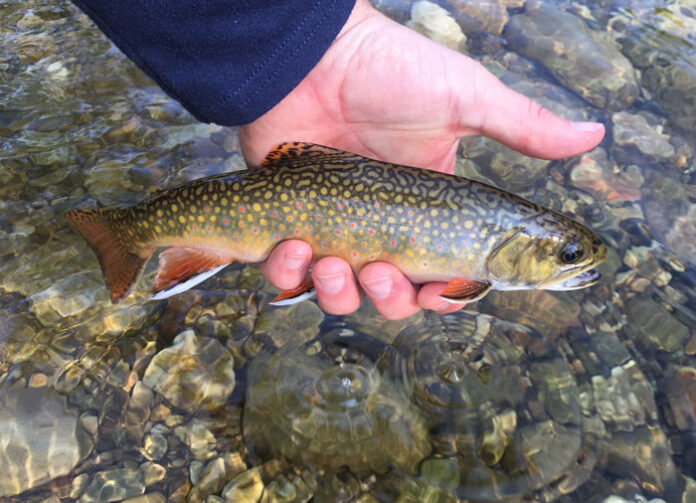In late summer, many of the valley rivers in Southwestern Vermont get low and warm. That’s when I head for the hills, by which I mean the Green Mountains. This beautiful stretch of the Appalachians is veined by tumbling freestone streams that are home to native brook trout, as well as the occasional brown that may have made its way up from lower in the system. Because of shade trees and springs flowing from the hillsides, the water in these streams stays cool, even in the heat of the summer.
Although adding a nymph dropper to a dry fly can be very productive, I prefer to catch these trout on the surface. I have nothing against the nymph; I just love the easy casting and seeing the fish come out from under a rock to eat. As you’ll see, I have a fondness for classic patterns, but I’m not above chucking a bit of foam. All I need for hours of fun are a box of drys, some desiccant, nippers, and a hemostat.
Here are my Top 10 favorite dry flies to fish this time of year.

The white wings of the Royal Wulff make the fly easy to see in the often rough water, and brook trout seem to love the peacock-herl body. When I first moved to Vermont more than two decades ago, my friend Dave Klausmeyer–the editor of Fly Tier magazine–took me to a tiny stream outside Bennington, and as he tied on a size 10 Wulff, he explained that it was the only fly he used in that situation.

You don’t often run into real hatches on mountain freestoners, but there always seem to be caddisflies around. If the big, bushy flies aren’t doing the trick, my go-to prospecting rig is a caddisfly with an ant as a dropper.

3. Stimulator (sizes 10 and 12)
The rocks on mountain streams are sometimes dotted with the husks of stoneflies that have recently hatched, and the fish are accustomed to pouncing on these meaty bugs whenever they get the chance.

4. PMX (sizes 8 to 14)
The PMX is an all-purpose attractor fly that sits love in the water. In larger sizes, it can imitate a hopper or a stonefly, while smaller versions mimic a caddisfly. It’s also a great indicator fly for when I want to fish a small ant that may sink below the surface in rough water.

In all honesty, I don’t know why fish eat this thing, but they do. It floats well, sits low in the water, and has wiggly legs that fish love. I’m always surprised when the smallest brookies are willing to whack this thing that’s a third as long as they are.

6. Schroeder’s Parachute Hopper (sizes 8 to 12)
When the hoppers are out, the fish are ready to strike should one of these big bugs get knocked into the water. The white post makes the fly easy to see in whitewater or low light, making this another great indicator pattern.

The Trude is a suggestive pattern, able to mimic a stonefly, a terrestrial, or a caddisfly. The white wing is easy to see, and the subtlety of the profile make this a good pattern to fish on long, slow pools where the fish have plenty of time to look before the decide to strike.

The Irresistible floats like a cork, making it useful for high, fast water and heavy riffles. It’s also dark enough to stand out in water with lots of white bubbles.

When flying ants are in the air, you’ll find them in the water, too. I don’t over-dress ant imitations because trout seem to like them just under the surface, as well. I always fish an ant as a dropper off a more visible pattern to save my eyesight. I carry all ant patterns in both black and cinnamon.

If I do want to fish an ant by itself, I choose the Para Ant because I can see the darned thing. The post doesn’t seem to bother the fish at all, and I can fish more accurately and effectively if I’m not constantly scanning the water for my fly.
Credit: Source link































